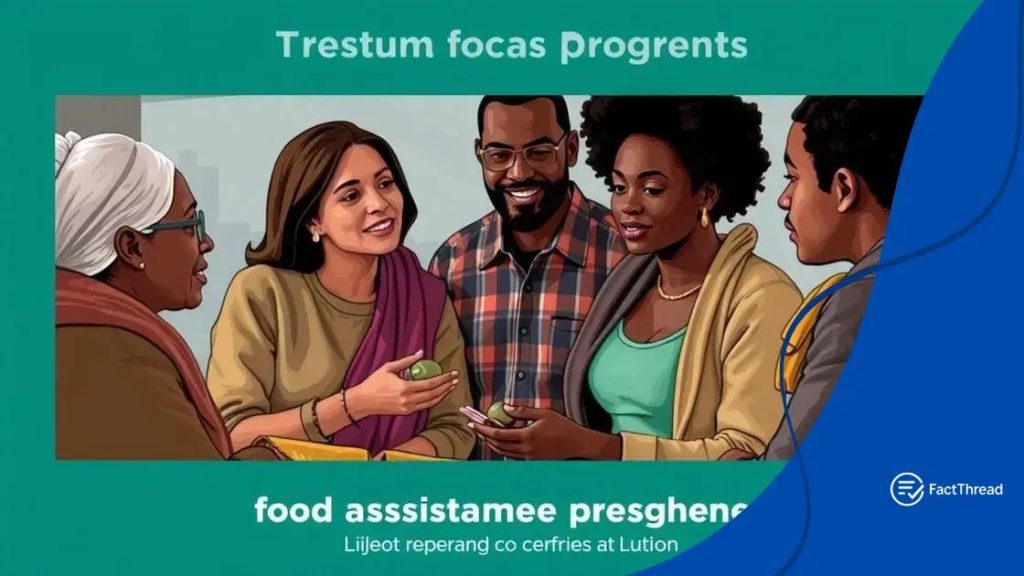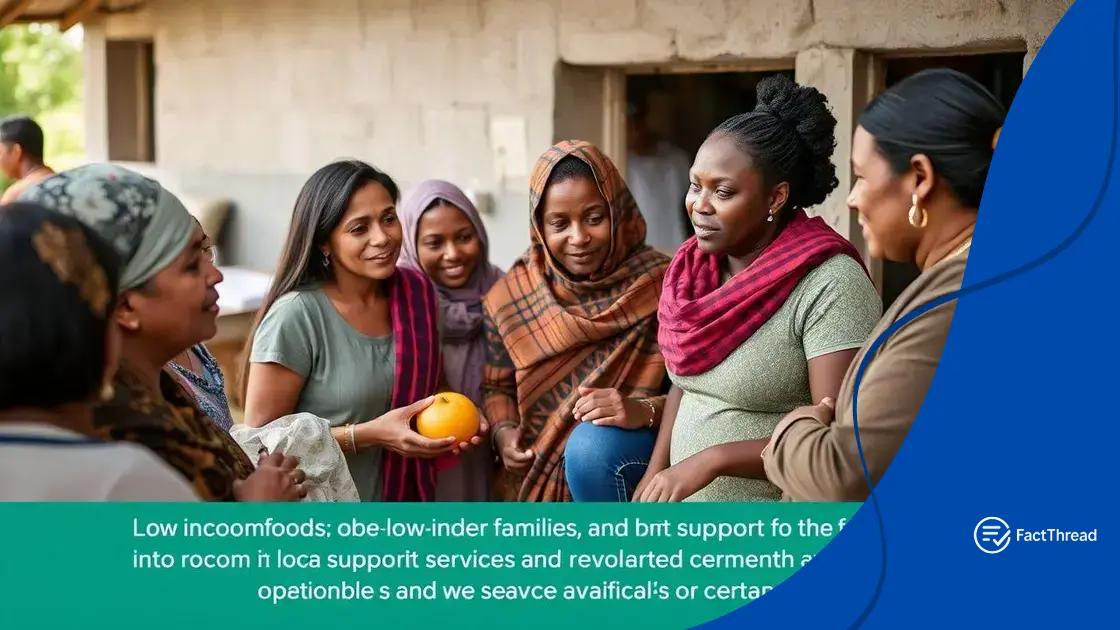Food stamp eligibility rules under review: what to know

Food stamp eligibility rules are evolving, impacting access to benefits for low-income families; staying informed, gathering necessary documents, and connecting with community resources are crucial for navigating these changes effectively.
Food stamp eligibility rules under review might change the way many families access assistance. With discussions ongoing, it’s essential to stay informed about what these alterations could mean for you.
Understanding food stamp eligibility criteria
Understanding food stamp eligibility criteria is crucial for families seeking assistance. The rules can sometimes feel overwhelming, but breaking them down makes it easier to grasp how they work. Knowing the requirements will help individuals determine if they qualify for benefits.
General Eligibility Requirements
To be eligible for food stamps, applicants must meet certain criteria. These include various factors such as income, household size, and citizenship status. Here are the key elements:
- Applicants must be U.S. citizens or qualified non-citizens.
- There are specific income limits based on household size.
- Assets may also be considered in some states.
- Work requirements may apply, depending on age and circumstance.
After understanding the basic criteria, it’s important to know how these rules are applied in different states. Many states have local guidelines that can affect eligibility. For instance, several regions have implemented their own income standards, which can be higher than federal limits. This means you might qualify even if you didn’t think you would.
How Household Size Affects Eligibility
Household size plays a significant role in determining eligibility for food stamps. The larger your household, the higher the income limit tends to be. This is intended to assist families with more dependents. When applying, make sure to account for everyone living in your home. Keep in mind that not everyone needs to be related to qualify as part of the same household.
Furthermore, some states provide what is known as a deduction for dependent care costs. This can be significant for working families who need to pay for childcare or elderly care while they work. Therefore, it’s essential to gather all relevant financial documents ahead of time to support your application.
There are also avenues for low-income families to receive expedited benefits. If you are in urgent need, knowing how to communicate your situation can expedite the process. Explore your options thoroughly.
Common Mistakes When Applying
Understanding common mistakes can help streamline the application process. Here are a few frequent errors to avoid:
- Underreporting income or household members.
- Failing to update changes in financial situations.
- Submitting incomplete documentation.
Taking the time to review your application before submission can prevent unnecessary delays.
In summary, grasping the food stamp eligibility criteria involves looking at income, household size, and state-specific rules. A good grasp of these components can make a significant difference in successfully acquiring assistance.
Current changes in the review process
Current changes in the review process for food stamp eligibility are reshaping how benefits are accessed. These adjustments aim to improve efficiency and ensure that qualifying individuals and families receive the aid they need. Understanding these dynamics is essential for those affected.
What’s New in the Review Process
Recently, several policy updates have been implemented across different states. These updates can impact everything from application reviews to the overall eligibility assessment. For instance, many states are moving towards automated systems which can speed up the decision-making process. This means that in some cases, applicants may receive results more quickly than before.
- Some regions are simplifying document submission requirements.
- Streamlined interviews may now be conducted over the phone.
- Increased outreach efforts are helping more people learn about their eligibility.
These changes are part of a broader effort to make the system more accessible. By reducing barriers, the aim is to help those who desperately need support to get it with less hassle.
Impact of Technology on Reviews
Technology is becoming a crucial factor in how the food stamp review process operates. Online portals and mobile apps are being introduced for easier access. Applicants can upload documents directly and check their application status anytime. This evolution minimizes the need for in-person visits, which can be a barrier for many.
In addition, the adoption of data analytics allows officials to better understand trends and needs in their communities. By assessing this data, adjustments can be made to meet those needs more effectively. For example, if a significant number of applicants are denied due to income misreporting, outreach can be tailored to educate families on accurate reporting techniques.
These improvements highlight the importance of evolving systems to better serve the population. It’s essential for applicants to remain informed about these shifts as they have the potential to affect outcomes.
Implications for low-income families

The implications for low-income families regarding food stamp eligibility rules are significant and can affect daily living. As these rules evolve, families must adapt to the changes to ensure they continue receiving necessary support. Understanding the effects of these guidelines can aid families in better navigating the system.
Financial Stability
Access to food stamps can be a lifeline for many low-income households. With food stamp benefits, families are better able to maintain a balanced diet. This assistance can free up funds for other essentials, such as housing or healthcare. When food expenses are reduced, families can focus on improving their overall financial situation.
- Food stamps can increase a family’s buying power.
- Healthy food options become more accessible.
- Families may experience reduced stress about meeting basic needs.
When families are financially stable, children can thrive in school, and parents can pursue job opportunities without worrying as much about hunger or food security.
Health and Nutrition
Nutrition is vital for all families, yet low-income households often struggle to afford healthy options. Food stamp assistance can dramatically impact health outcomes. With this help, families can access fruits, vegetables, and other nutritious foods that they may have previously deemed unaffordable.
However, if the eligibility criteria tighten, some families may face challenges. Losing access to benefits can lead to an increase in food insecurity. Children and adults alike may turn to cheaper, less nutritious options, leading to long-term health issues.
Community and Support Systems
The implications also extend beyond individual households to communities. When families have access to food assistance, they are more likely to contribute positively to their local economies. Schools and community centers strengthen as families can participate in programs without the burden of financial strain.
Building support networks becomes essential, and local organizations often step in to help families navigate changes. These resources can provide guidance on applying for more assistance or finding employment opportunities. Maintaining connection to community resources can help mitigate the challenges posed by changes in eligibility.
Ultimately, the impacts of food stamp eligibility rules directly affect household stability. It is critical for families to stay informed about changes and seek assistance when needed.
How to prepare for potential changes
Preparing for potential changes in food stamp eligibility is essential for families relying on this support. With recent updates and ongoing reviews, being proactive can make a significant difference. Knowing what steps to take allows families to adapt smoothly.
Stay Informed About Policy Changes
Regularly check for news and updates on food stamp programs. State agencies often provide information on their websites about any changes that may affect eligibility. Subscribing to newsletters or following official social media accounts can help you stay in the loop.
- Visit the official government website for food assistance.
- Sign up for email notifications about program updates.
- Engage with local advocacy groups for the latest news.
Being aware of these changes creates an opportunity for families to adjust their budgets or seek additional resources if needed.
Gather Necessary Documentation
Collecting all required documents beforehand can ease the application process if eligibility rules tighten. Important paperwork may include:
- Proof of income, such as pay stubs or tax returns.
- Identification and residency verification.
- Information about household members, including ages and relationships.
Having these items ready can speed up the process and ensure that submissions are complete.
Additionally, consider keeping track of changes in your financial situation. Reporting these changes promptly to your local office can help maintain your eligibility status and prevent unexpected disruptions in benefits.
Connect with Community Resources
Building a network with local organizations offers added support. Community groups often provide resources to help families navigate changes in eligibility. They may offer workshops or information sessions about upcoming changes and how to prepare effectively.
Local food banks and charities can also serve as resources for families facing food insecurity. Establishing connections with these organizations can provide a safety net during uncertain times.
Being proactive and preparing for potential changes in food stamp eligibility will help families face any transitions with confidence. The landscape may shift, but with the right preparation, families can ensure they continue to receive the support they need.
Resources for staying informed about food stamps
Staying informed about food stamps is crucial for anyone who relies on these benefits. Knowing where to find reliable information can make all the difference. There are several resources available to help families access the most up-to-date information about food stamp eligibility and other related topics.
Official Government Websites
The first place to look for information is on official government websites. These sites often provide the most accurate and current updates on food stamp programs. For instance, the U.S. Department of Agriculture (USDA) has a dedicated page for the Supplemental Nutrition Assistance Program (SNAP), which includes valuable resources.
- Visit the USDA’s SNAP page for eligibility guidelines.
- Check state-specific websites for local information.
- Access online applications and forms for easier submission.
These resources can ensure that you have the right information straight from the source.
Local Community Organizations
Many local organizations and nonprofits focus on supporting families facing food insecurity. These groups often offer assistance in navigating applications and understanding eligibility. Connecting with these organizations can provide you with personalized support and guidance.
Additionally, these organizations frequently hold workshops or informational sessions. Attending these can help families learn about changes in the program and how to prepare for them. Some key organizations to connect with include:
- Food banks and pantries.
- Community action agencies.
- Local advocacy groups focused on food security.
Engaging with your community increases your chances of staying informed and receiving the help you need.
Social Media and Online Forums
Social media platforms can also be valuable for receiving real-time updates. Follow official government accounts for announcements about changes to food assistance programs. Joining online forums where individuals discuss their experiences with food stamps can also provide helpful insights. Here are a few tips for using social media effectively:
- Follow relevant hashtags to keep up with trending topics.
- Participate in community discussions to share experiences and resources.
- Look for groups dedicated to food assistance and poverty alleviation.
Staying connected to others facing similar challenges can provide emotional support alongside information.
Overall, utilizing these resources will help families stay informed about their food stamp eligibility and navigate the program effectively.
FAQ – Frequently Asked Questions about Food Stamp Eligibility
What should I do if I think my eligibility for food stamps has changed?
If you believe your eligibility has changed, contact your local food stamp office to report changes and submit a new application if necessary.
How can I find out if I qualify for food stamps?
You can determine your eligibility by visiting the official government website or using their eligibility calculator tool to assess your situation.
What documents do I need to apply for food stamps?
Typically, you’ll need proof of income, residency, and household size. Check your local office’s requirements for specific documentation.
What resources are available for assistance with food stamps?
Community organizations and food banks can provide guidance and support in navigating the food stamp application process.